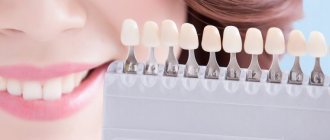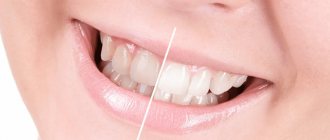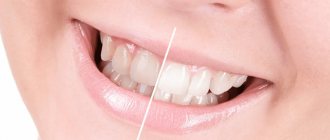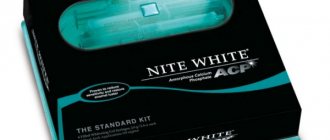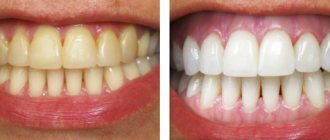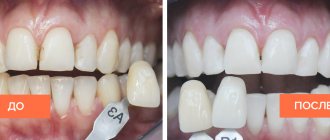Author of the article:
Soldatova Lyudmila Nikolaevna
Candidate of Medical Sciences, Professor of the Department of Clinical Dentistry of the St. Petersburg Medical and Social Institute, Chief Physician of the Alfa-Dent Dental Clinic, St. Petersburg
Teeth whitening with oxygen is one of the most common ways to make your smile brighter and more attractive.
The fact is that even with careful care, the enamel gradually becomes more yellow. It's all about the food we eat. Tea, coffee, red wine, colored soda and many other products leave traces of their presence on our enamel. And since the surface of the tooth is porous, it quickly absorbs coloring pigments and accumulates them over time, causing the yellowness to become more intense. In addition, smoking and bacterial activity contribute to its manifestation.
All this leads to the need to periodically return the natural color of teeth.
But if you want your smile to shine no worse than that of Hollywood stars, you need oxygen whitening. Only it can truly effectively remove yellow color.
The mechanism of this whitening method
What is oxygen teeth whitening? This is a method that involves the activation of hydrogen peroxide or urea. The fact is that under certain conditions (which are created using special means and methods, but more on that later), peroxide molecules split into water and atomic oxygen.
Oxygen atoms, in turn, actively penetrate the structure of enamel and dentin, bind to pigment molecules, make them water-soluble and literally clean them out of the pores. Thus, the pigmented areas become discolored, and the patient receives a snow-white smile.
Important! To achieve a high result, that is, lightening by many tones, ordinary peroxide from the pharmacy will not work. We need special products with a balanced composition and high concentration of active ingredients. They are usually produced in the form of special gels, which doctors apply to the enamel and activate. Or in the form of toothpaste, strips and pencils - with these types of products oxygen whitening can be carried out at home, but the effect will be lower than from office procedures, since they have a lower content of the active substance.
Advantages
The method is gaining popularity because it has advantages that distinguish it from others:
- in one session, the enamel brightens by 9–10 shades on the Vita scale;
- the patient does not feel pain during the procedure;
- the session takes 40 minutes;
- the enamel is not damaged;
- there is no danger of touching soft tissues (gums, lips, mucous membranes);
- the effect lasts up to 2–3 years.
Operating principle: under the influence of lamp light, oxygen is released from the gel applied to the teeth. It fights bacteria and destroys plaque.
Having experienced teeth whitening with active oxygen once, the patient will return to it in the future, because at a relatively low price the method quickly brings the desired result and has a minimum of side effects.
How does oxygen activation occur?
As noted above, to carry out oxygen bleaching in order to lighten the enamel by many tones at once (5-12), peroxide alone in a high concentration is not enough. A catalyst is needed to break it down and release oxygen atoms. Dentists use various means as such an activator:
- chemical compounds and reagents,
- halogen, LED, ultraviolet, LED lamps and even conventional polymerization lamps (for example, Klox biophotonic technology): many doctors today consider cold lamps to be the best, since they produce so-called cold light with a temperature of about 37 degrees, which practically does not heat the enamel, which makes the procedure quite comfortable and painless,
- laser: acts very carefully, precisely, and at the same time has a disinfecting, anti-inflammatory and even strengthening effect.
What does a teeth whitening lamp look like?
Where to do Zoom teeth whitening in Moscow
Mitino Dental Center offers professional teeth whitening services with Zoom 4 gel at an affordable price. All doctors of the clinic are specialists with extensive experience, and all manipulations and procedures are carried out only with the help of modern equipment. Therefore, we guarantee our patients comfort and maximum safety.
For a consultation or to make an appointment with a dentist, fill out the online form on the website or call +8(499)370-48-81.
Indications and contraindications for the procedure
The desire to make a snow-white smile, as well as yellowness, discoloration of teeth and stains on the enamel caused by food and drinks, wearing braces, smoking, some types of hypoplasia and fluorosis (spotted forms) are all reasons to consider oxygen whitening. But for the procedure to be effective and safe, the following contraindications must be excluded:
- age up to 18 years, pregnancy and breastfeeding,
- the presence of multiple restorations (fillings, crowns, dentures) in the smile area,
- untreated caries, pulpitis, periodontitis,
- acute inflammation of the gums and mucous membranes,
- erosions, wedge-shaped defect, severe forms of fluorosis and hypoplasia,
- increased sensitivity, abrasion of enamel, multiple cracks and chips,
- the period of orthodontic treatment, especially when the patient wears fixed systems like braces.
Methods of oxygen lightening of enamel
As for oxygen teeth whitening, people who want to transform their smile in this way have many different options that differ in cost and, naturally, in results. You can use professional methods, or you can give preference to home approaches.
Expert opinion
Victoria Nikolaevna Kashaeva
Specializations: Dental hygienist, therapist
Experience: 5+
“In essence, oxygen teeth whitening is not a separate or unique technique. It would be more correct to say that this is a general concept. Today, in almost all cases, products containing hydrogen or urea peroxide, which break down into oxygen atoms, are used to lighten enamel. The only difference is the concentration of the active substance, the composition of other components (the gel may contain fluorine, potassium, etc.), as well as the method of activating the peroxide.”
Professional ways
The largest group of methods based on the separation of oxygen atoms from peroxide is photobleaching. The catalysts here are lamps. And the most popular, safe and effective techniques include: ZOOM, Amazing White, Luma-Arch, Beyond Polus.
Laser whitening, when the gel applied to the enamel is activated by a laser beam, is deservedly in demand today. This technique is one of the safest, painless, allows you to work with complex defects and even improve the appearance of “tetracycline” teeth. True, the cost of procedures involving a laser is quite high, starting from 20 thousand rubles.
What does a laser whitening procedure look like?
Let's consider the most budget-friendly methods among professional ones. For example, chemical oxygen teeth whitening using the American Opalescence method. It is also carried out under the supervision of a doctor (but there are a variety of remedies for home use) and only after careful preparation. However, you shouldn’t expect too much effect here, a maximum of 4-6 tones. It is also important to understand that chemical methods, due to the emergence of safer and more comfortable ones, are gradually fading into the background, so dentists offer them less often.
Another fairly budget option is the so-called cosmetic lightening. Popular technology – Magic White. The peroxide gel is activated by an LED lamp. And the creator of the method assures that not only dentists, but also cosmetologists can carry out the procedures, which saves the patient’s time and money. Agreeing to this, you need to understand that cosmetologists cannot always competently assess the condition of the oral cavity of the person who contacts them, as well as exclude contraindications. In addition, cosmetologists will not be able to carry out preparations, for example, professional hygiene in order to remove bacterial plaque, which will be an obstacle to ideal whiteness.
There is also biophotonic technology "Klox". The creators of the method report that to carry out the procedures and activate hydrogen peroxide, all you need is a polymerization lamp, which is available in any dental office.
In cases where a patient goes to the dentist with discolored, pulpless (without nerve) teeth, the doctor can also offer intracanal (endodontic) whitening based on the action of peroxide and atomic oxygen.
Home methods and remedies
Again, professional products can be used for this purpose. Many well-known brands, for example, Zoom, Amazing White, Opalescence, produce products for home use, but emphasize that this requires preparation of the oral cavity and supervision by a dentist. At a minimum, a doctor should select and prescribe medications. Usually a special gel is included, which is applied to the enamel and kept according to the instructions. For the best effect, it is recommended to use the gel with the mouth guards included in the kit or purchased separately at the dentist.
Complete kit for whitening at home
Another option is stripes and pencils. For example, Crest strips, available in a wide range, are very popular, effective and relatively safe.
In addition, many people today choose a product such as toothpaste. True, you should be very careful here. If you want to carry out oxygen bleaching, then not all bleaching pastes are suitable for this. Most of them are based on mechanical action, when plaque is removed using abrasives included in the composition (for example, charcoal and bamboo charcoal). And you need to look for exactly those that contain hydrogen peroxide or carbamide. For example, ROCS[1] Pro Oxywhite (“Oxygen bleaching”).
But those who like to experiment with folk recipes try to lighten the enamel using pharmaceutical peroxide 3%. In fact, upon contact with air, oxygen is also released from it, but saliva very quickly neutralizes its effect. Due to the low concentration of the product and its rapid neutralization, the effect of such lightening will be minimal. You can read more about this in the feature article on the website.
Why do teeth turn yellow?
There are many methods of whitening; it is recommended to decide which one to choose together with your dentist.
The doctor will be able to identify the cause of the color change and select a treatment method that is effective in a particular case. To effectively whiten your incisors, it is recommended to first determine why they are yellow. Healthy teeth are not snow-white by themselves; the outer layer naturally has a milky or beige tint, which is the physiological norm. In some people, the pigment is a little brighter, causing the smile to appear yellowish. The reason is the high concentration of minerals that make the incisors strong.
If the incisors themselves are snow-white and matte, this is a sign of negative changes in the composition of the enamel. Such teeth can soon crumble and they are susceptible to caries and are easily damaged by physical impact.
A yellow tint does not always indicate oral health. If a person has naturally milky incisors, but after a few years they have turned very yellow, the reason may be the following:
- consumption of coloring foods in large quantities - coffee, tea, bright berries, food with dyes;
- smoking, including hookah;
- the presence of tartar and plaque due to insufficient hygiene;
- age-related changes in enamel color;
- pathologies of the oral cavity.
The smile turns yellow in older people, this is due to changes in the outer layer, it becomes porous and dyes penetrate well inside.
Pros and cons of professional oxygen bleaching
If we are talking about professional products that are used under the supervision of a dentist, then the advantages are as follows:
- This is a choice of completely different methods,
- this is an achievement of high results - you can achieve enamel whitening by 10-12 shades (depending on its initial condition, color and the patient’s desire),
- it is safe for teeth and gums, taking into account contraindications and individual characteristics of the patient. Experienced doctors will not carry out the procedure without careful preparation, sanitation of the oral cavity, strengthening of enamel, without protective equipment (for example, liquid rubber dam for gums),
- it's fast: the effect is achieved in just 1 visit to the clinic.
The disadvantages include the relatively high cost of such procedures. You also need to be prepared for the fact that many patients’ teeth become very sensitive for some time after lightening. To make this go away faster and to minimize discomfort, you will need to strengthen the enamel with special pastes and avoid hot and irritating foods.
The disadvantages include the fact that in order to maintain a long-term effect, the patient will have to follow a “white” diet after the procedure, stop smoking and drinking red wine, and do not skip daily teeth brushing and professional hygiene. But again, all these rules are mandatory after any whitening method, even if we are talking about home remedies.
Saving the result
In order for your teeth to be snow-white for a long time, you must first follow a clear diet and take more careful care of them. Specialized pastes and rinses from the Asepta series will help you with the latter.
Sources:
- Report on determining/confirming the preventive properties of toothpaste “ASEPTA PLUS” GENTLE WHITENING” Author: doctor-researcher A.A. Leontyev, head Department of Preventive Dentistry, Doctor of Medical Sciences, Professor S.B. Ulitovsky First St. Petersburg State Medical University named after. acad. I.P. Pavlova, Department of Preventive Dentistry
- Clinical studies of antisensitive toothpaste “Asepta Sensitive” (A.A. Leontyev, O.V. Kalinina, S.B. Ulitovsky) A.A. LEONTIEV, dentist O.V. KALININA, dentist S.B. ULITOVSKY, Doctor of Medical Sciences, Prof. Department of Therapeutic Dentistry, St. Petersburg State Medical University named after. acad. I.P. Pavlova
- The role of anti-inflammatory rinse in the treatment of periodontal diseases (L.Yu. Orekhova, A.A. Leontyev, S.B. Ulitovsky) L.Yu. OREKHOVA, Doctor of Medical Sciences, Prof., Head of Department; A.A. LEONTIEV, dentist; S.B. ULITOVSKY, Doctor of Medical Sciences, Prof. Department of Therapeutic Dentistry of St. Petersburg State Medical University named after. acad. I. P. Pavlova
- Report on determining/confirming the preventive properties of commercially produced personal oral hygiene products: Asepta toothpaste used in combination with Asepta mouthwash and Asepta gum balm Head. Department of PFS Doctor of Medical Sciences Professor S.B. Ulitovsky St. Petersburg State Medical University named after Academician I.P. Pavlova. Faculty of Dentistry. Department of Preventive Dentistry.
Pros and cons of home remedies
If you use strips, pencils, paste, or just a regular bottle of peroxide from the pharmacy, which are used for oxygen bleaching, then the most obvious advantage here is budget savings. Also, if your oral cavity is in good enough condition, you regularly visit the dentist, and your approach is reasonable (if you do not carry out procedures frequently and follow the instructions), the likelihood of harming the enamel using such means is minimal. Thus, it is lower than with the unlimited use of abrasives with soda, coal, and lemon.
This is what teeth whitening strips look like
Another plus is that with strips and pencils, for example, you can also quite successfully lighten the enamel by 3-5 tones, which is more than enough for many people. The resulting color will definitely not be unnatural, too white.
As for the disadvantages, the following points must be taken into account:
- without prior consultation and examination by a dentist, you may overlook contraindications that are important to exclude for safe and effective whitening procedures,
- Not everyone needs to lighten the enamel by 3-5 tones. Some people want more, and only professional technologies can achieve this,
- there is a risk of injuring the enamel and gums.
Pastes
Have you decided to use a homemade oxygen whitening paste? Buy:
- Rembrandt+;
- Splat extreme;
- ROCS.
The first allows you to make the enamel lighter by 5 tones. The second gives approximately the same effect, preventing demineralization of teeth. The plaque will be removed completely after a few uses.
Important. If you have opted for lightening pastes, do not overuse them: this leads to demineralization of the enamel. Four times a week is enough to gradually whiten crowns without harming them.
ROCS paste is approved by dentists for its high effectiveness and safety.
